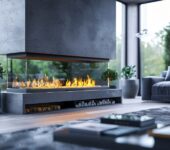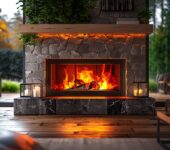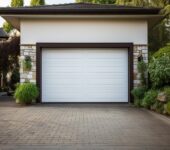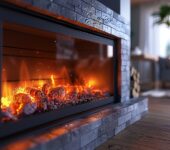Table of Contents
Have you ever wondered how do you extinguish a fireplace?
Fireplaces can add warmth and ambiance to any home, but it’s important to understand how they work and the potential dangers they present. This article covers everything you need to know about fireplaces, from the different types to the signs of a fire hazard. We’ll also discuss the importance of extinguishing a fire properly and share some essential safety tips to keep in mind when using a fireplace.
Let’s explore the world of fireplaces together!
Understanding Fireplaces
Understanding fireplaces is essential for ensuring the safety of your home and preventing potential hazards associated with fireplace usage.
Fireplaces come in various types such as wood-burning, gas, electric, and ethanol fireplaces, each functioning differently but all capable of igniting a fire in your home. Wood-burning fireplaces rely on logs or pellets for fuel, while gas fireplaces use natural gas or propane. Electric fireplaces produce simulated flames using LED lights and can be plugged into an outlet. Ethanol fireplaces burn bioethanol fuel.
All types of fireplaces can pose risks if not properly maintained or monitored, leading to potential dangers such as smoke inhalation, carbon monoxide poisoning, or even chimney fires.
What Are the Different Types of Fireplaces?
Fireplaces come in various types, such as wood-burning fireplaces, gas fireplaces, and ventless fireplaces, each utilizing different fuel sources and venting methods.
- Wood-burning fireplaces are known for their traditional ambiance and the crackling sounds of burning wood. They require a steady supply of firewood and proper ventilation to ensure efficient burning and proper airflow.
- Gas fireplaces, on the other hand, offer convenient heating with the flip of a switch, using natural gas or propane as fuel. Venting for gas fireplaces can be through a direct vent, vent-free, or a traditional chimney.
- Ventless fireplaces, as the name suggests, do not require a vent and are designed to burn clean and efficiently, utilizing natural gas or propane as fuel.
How Do Fireplaces Work?
Fireplaces work by generating heat through the combustion of fuel, typically wood or gas, in the presence of oxygen to produce a cozy and warm ambiance in a room.
The burning process in a fireplace begins with kindling small pieces of wood to ignite a fire. As the fire grows, it consumes larger logs or gas, releasing heat energy in the process. The heated air rises through the chimney, drawing in fresh oxygen to sustain the combustion. The chimney not only channels smoke and gases out of the room but also maintains the necessary airflow for efficient burning. This continuous cycle of fuel, oxygen, and heat sustains the mesmerizing flames that are a hallmark of traditional fireplace charm.
What Are the Dangers of Fireplaces?
Fireplaces pose several dangers, including creosote buildup in the chimney, carbon monoxide poisoning, and the risk of chimney fires if not properly maintained or used.
When a fireplace is regularly used, creosote, a highly flammable substance produced by wood-burning, can accumulate in the chimney over time. This buildup can ignite and lead to a dangerous chimney fire. In addition, incomplete combustion in a fireplace can result in the release of carbon monoxide, a colorless and odorless gas that can be lethal if inhaled in high concentrations. Therefore, it is essential to ensure proper ventilation and regular chimney inspections to prevent these hazardous situations.
Creosote Buildup
Creosote buildup in the chimney is a common hazard that can lead to chimney fires if not regularly inspected and cleaned as part of routine maintenance.
This black, tar-like substance forms when wood or fossil fuels are burned and can accumulate over time, restricting proper airflow and creating a highly flammable environment.
Without regular maintenance, creosote buildup can ignite, resulting in a dangerous chimney fire that can quickly spread to the rest of the house. Neglecting chimney cleaning not only puts your property at risk but also endangers the lives of those inside.
Ensuring proper chimney maintenance is crucial for preventing these potentially devastating outcomes.
Carbon Monoxide Poisoning
Carbon monoxide poisoning is a serious threat linked to incomplete combustion of fuel in poorly ventilated spaces, emphasizing the need for carbon monoxide detectors and proper ventilation for safety.
Breathing in carbon monoxide can lead to symptoms like headaches, dizziness, nausea, and in severe cases, unconsciousness or even death. The installation of carbon monoxide detectors is crucial in homes with fireplaces or gas appliances, as they can alert residents to dangerous levels of this odorless, colorless gas.
Ensuring adequate ventilation in rooms with fireplaces is essential to allow for the proper dispersion of emissions. Regular maintenance of the fireplace and chimney, along with using high-quality fuel, can reduce the risk of carbon monoxide exposure. It is also important to have a professional inspect and clean the chimney annually to prevent blockages that can lead to backdrafts and increased carbon monoxide levels.
Chimney Fires
Chimney fires can pose a significant hazard, requiring immediate action and the use of a fire extinguisher following emergency instructions to suppress the fire effectively.
When a chimney fire occurs, the risks can be severe, including property damage and potential harm to occupants. It is crucial to have a clear emergency plan in place so that everyone knows what to do in such a situation. Ensuring the safety of individuals is paramount, and having a well-maintained fire extinguisher nearby is essential for quick response. Understanding the proper techniques for extinguishing chimney fires, such as using a chemical fire extinguisher or calling the fire department if necessary, can prevent the situation from escalating further.
What Are the Signs of a Fire Hazard in a Fireplace?
Recognizing signs of a fire hazard in a fireplace is crucial for identifying potential safety risks, such as smoke backing up into the room, unpleasant smells, and soot buildup.
In addition to these common signs, another warning indicator of a fireplace fire hazard is the presence of creosote buildup, which is a highly flammable substance that can lead to chimney fires.
Cracks or gaps in the fireplace structure can also pose a potential risk by allowing embers to escape and ignite nearby flammable materials.
If you notice discoloration on the walls or ceiling near the fireplace, it could indicate overheating and a potential fire danger.
Regular inspection and maintenance are essential to ensure the safe operation of a fireplace and prevent hazardous situations.
Smoke Backing Up Into the Room
Smoke backing up into the room from a fireplace indicates a potential hazard, often signaling issues such as poor ventilation, smoldering fires, or blockages in the chimney.
When smoke is unable to escape the fireplace properly, it can fill the room with harmful gases like carbon monoxide, posing a serious health risk to occupants. The presence of smoke indoors can also lead to respiratory issues, eye irritation, and even potential fire outbreaks if left unaddressed. Proper ventilation plays a crucial role in ensuring that smoke is efficiently directed out of the living space, reducing the chances of hazardous buildup.
Regular chimney inspections and cleanings are essential to prevent blockages and ensure that smoke can exit freely, minimizing the likelihood of dangerous smoke backup incidents.
Unpleasant Smells
Detecting unpleasant smells from a fireplace can indicate potential issues that require immediate attention, emphasizing the importance of routine inspection and maintenance to prevent safety hazards.
Apart from being a nuisance, foul odors from fireplaces can signal underlying problems such as creosote buildup, gas leaks, or even chimney blockages. Regular inspections by a certified professional play a crucial role in identifying these issues early on, ensuring the safe operation of your fireplace.
When encountering unusual smells, it’s essential to promptly address them by checking for visible signs of damage or irregularities, such as soot deposits, cracks in the chimney, or improper ventilation. Taking proactive measures can help mitigate risks and maintain a healthy indoor environment for you and your family.
Soot Buildup
Accumulation of soot in a fireplace or chimney poses a hazard due to potential blockages and fire risks, necessitating regular cleaning by a professional chimney sweep.
The buildup of soot occurs as a byproduct of burning wood or other materials in the fireplace, gradually forming a sticky and flammable residue. Over time, this soot can restrict the airflow in the chimney, leading to poor ventilation. In addition to blocking the escape of smoke, soot can also ignite under high temperatures, triggering a chimney fire.
It is crucial to understand that regular chimney cleaning not only enhances the efficiency of your fireplace but also safeguards your home from the dangers associated with soot accumulation.
How Do You Extinguish a Fireplace?
Extinguishing a fireplace fire requires specific methods such as closing the damper, using a fire extinguisher, dousing with water, or contacting the fire department for assistance.
When tackling a fireplace fire, the first step is to close the damper to restrict oxygen flow and slow down the combustion process.
Utilizing a fire extinguisher can be effective in extinguishing small flames by aiming the nozzle at the base of the fire and sweeping back and forth.
If the fire continues to escalate, carefully dousing it with water from a safe distance can help smother the flames.
In dire situations where the fire is uncontrollable, involving emergency services is crucial to ensure the safety of everyone involved.
Close the Damper
Closing the damper is a crucial step in extinguishing a fireplace fire as it restricts oxygen flow, helping to suffocate the flames and contain the emergency.
By controlling the airflow with the damper, the fire’s access to necessary oxygen is reduced, slowing down its combustion rate. This intervention is fundamental in preventing the fire from spreading further and gaining intensity. When the damper is closed, the limited oxygen supply causes the fire to lose its ability to sustain itself, ultimately aiding in its suppression.
Proper damper operation plays a significant role in fire containment by cutting off the fire’s oxygen source, leading to the fire burning out more rapidly and facilitating quicker suppression by firefighters.
Use a Fire Extinguisher
Using a fire extinguisher is an effective method to suppress fireplace fires, requiring proper knowledge of its operation, safety procedures, and regular maintenance for optimal performance.
When faced with a fireplace fire, the first step is to remain calm and assess the situation. Ensure that everyone in the vicinity is aware of the fire and is safe. Next, grab the fire extinguisher and check its pressure gauge to ensure it is operational. Remember to aim the nozzle at the base of the flames and squeeze the handle in a sweeping motion.
After successfully putting out the fire, it is crucial to inspect the extinguisher, recharge it if necessary, and store it in a readily accessible location for future emergencies.
Smother the Fire with Baking Soda
Smothering a fireplace fire with baking soda can help suppress the flames by reducing heat and suffocating the fire, providing an alternative method for extinguishing small fires.
When baking soda is applied to a fire, it releases carbon dioxide gas, which acts as a fire retardant by displacing oxygen—a crucial component for combustion. By smothering the fire in this way, the flames are deprived of the oxygen necessary to sustain their growth, leading to a decrease in temperature and effectively stopping the fire from spreading further. This simple yet effective technique can be particularly useful in situations where traditional water-based methods may not be practical or safe to use.
Call the Fire Department
Contacting the fire department in case of a fireplace fire is essential for prompt and professional assistance. They will extinguish the fire safely and efficiently.
Their expertise in fire suppression techniques and equipment allows them to swiftly address the situation. This will minimize damage and ensuring the safety of all occupants.
Firefighters are trained to handle various types of fires, making them vital responders in such emergencies. They can handle fires including those involving chimneys and fireplaces.
Seeking expert assistance from the fire department can prevent a small fire from escalating into a larger, catastrophic event, ultimately protecting lives and property.
What Are Some Safety Tips for Using a Fireplace?
Adhering to safety tips is crucial when using a fireplace. Some safety tips include annual chimney inspections by professionals, and never leaving fires unattended. In addition, keeping flammable objects away, and installing a carbon monoxide detector are important safety tips.
It’s important to ensure that the fireplace is clear of any debris or obstructions before lighting a fire. Regularly check for creosote buildup in the chimney, as this can pose a fire hazard. When monitoring the fire, use a screen or glass doors to prevent sparks from escaping. Keep children and pets at a safe distance from the fireplace. Finally, never use flammable liquids to start or enhance a fire. Being vigilant and proactive about safety measures can significantly reduce the risk of accidents or harm associated with fireplace usage.
Have a Professional Inspect and Clean the Chimney Annually
Annual chimney inspections and cleanings by professionals from Dreifuss Fireplaces are essential precautions to prevent chimney fires. They also ensure proper ventilation, and maintain fireplace safety.
It is crucial to understand the significance of these routine check-ups, as they can detect potential issues. These issues include creosote buildup, blockages, or structural damage that could lead to hazardous situations. Regular maintenance not only extends the lifespan of your chimney. It also enhances its efficiency, resulting in better indoor air quality and reduced energy costs.
Taking these preventive measures can also help in spotting any early signs of wear and tear. This will save you from costly repairs or replacements in the future.
Never Leave a Fire Unattended
Leaving a fire unattended poses a significant hazard as it can lead to uncontrolled burning, smoldering, and potential fire outbreaks. These emphasize the need for constant monitoring and control.
It is crucial to always stay vigilant when dealing with fires to prevent any mishaps. By staying present and actively monitoring the fire, you can swiftly address any issues that may arise. As a consequence, the risk of a small flame escalating into an uncontrollable inferno is reduced. Utilizing safety precautions are essential steps in fire supervision. These steps include having a fire extinguisher nearby and ensuring the fire is properly extinguished before leaving the area. Remember, fire safety is a shared responsibility and requires everyone to do their part in preventing dangerous situations.
Keep Flammable Objects Away from the Fireplace
Maintaining distance and keeping flammable objects away from the fireplace is crucial to prevent fire hazards. This ensures a safe barrier between potential fuel sources and the fire.
It’s highly essential to recognize the risks associated with having flammable materials near a fireplace. The combination of heat and combustible items can lead to rapid fire spread. Safety barriers, such as screens or gates, play a vital role in creating a protective boundary. This boundary reduces the chances of accidental ignition. By establishing a hazard-free zone around the fireplace, you not only enhance the overall fire safety of your home. You also promote a secure environment for everyone in the household.
Install a Carbon Monoxide Detector
Installing a carbon monoxide detector near the fireplace is crucial for early detection of harmful gas levels. This compliments smoke alarms and ensures proper ventilation for enhanced safety.
These detectors serve as a vital line of defense against the silent threat of carbon monoxide. Carbon Monoxide is a colorless and odorless gas. It can be released during incomplete combustion of fuel sources like gas, wood, or oil. By alerting occupants to the presence of carbon monoxide, detectors play a crucial role in preventing carbon monoxide poisoning. This poisoning is dangerous, and can lead to symptoms like dizziness, nausea, and even death. When placed strategically near the fireplace, detectors work in tandem with smoke alarms. Consequently, they both offer comprehensive protection against fire hazards and gas leaks.
Frequently Asked Questions
1. How do fireplaces work?
Fireplaces generate warmth by burning fuel, like wood or gas, with a chimney providing airflow for combustion and venting smoke.
2. What are the main dangers of fireplaces?
Key dangers include creosote buildup, which can cause chimney fires, and carbon monoxide poisoning from incomplete fuel combustion.
3. Why is annual chimney inspection important?
Annual inspections prevent chimney fires and ensure efficient and safe fireplace operation by identifying and resolving issues like creosote accumulation.
4. What should you never do with an active fireplace?
Never leave a fire unattended to avoid uncontrolled burning and potential fire outbreaks.
5. How can you prevent fireplace-related hazards?
Keep flammable items away, never use accelerants, ensure proper installation and maintenance, and install carbon monoxide detectors for safety.
6. How do you extinguish a fireplace fire?
First, close the damper to limit oxygen. Next, use a fire extinguisher on small flames. Finally, call the fire department for larger fires.
Latest Articles

Garage Door With Glass Windows: Merge Aesthetics With Practicality
Table of Contents1 What Is a Garage Door with Glass Windows?2 What Are the Types of Glass Used for Garage Doors?3 What Are the Benefits

How Many Fireplaces Can I Have In My Home?
Table of Contents1 What Is a Fireplace?2 What Are the Different Types of Fireplaces?3 How Many Fireplaces Can You Have in Your Home?4 What Are
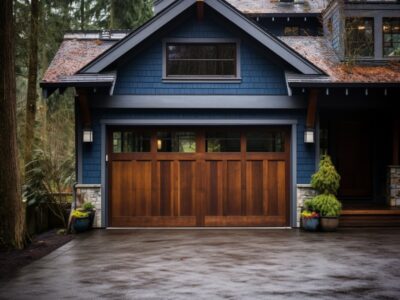
Window Garage Door: Framing Views, Enhancing Aesthetics
Table of Contents1 What Is a Window Garage Door?2 How Does a Window Garage Door Work?3 What Are the Benefits of Having a Window Garage







